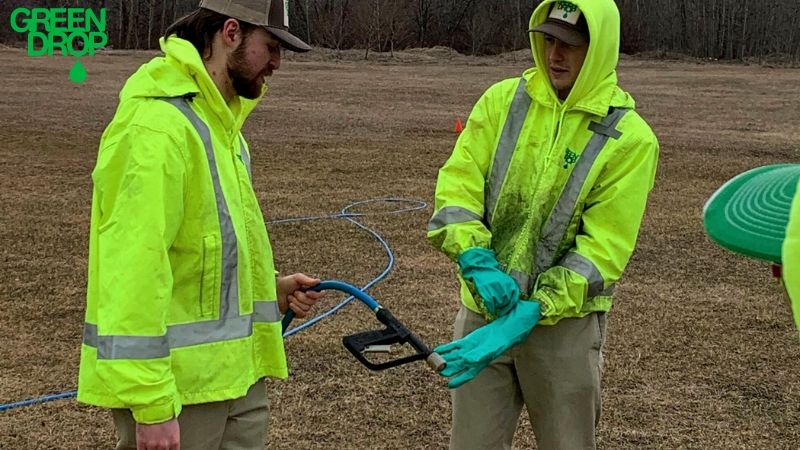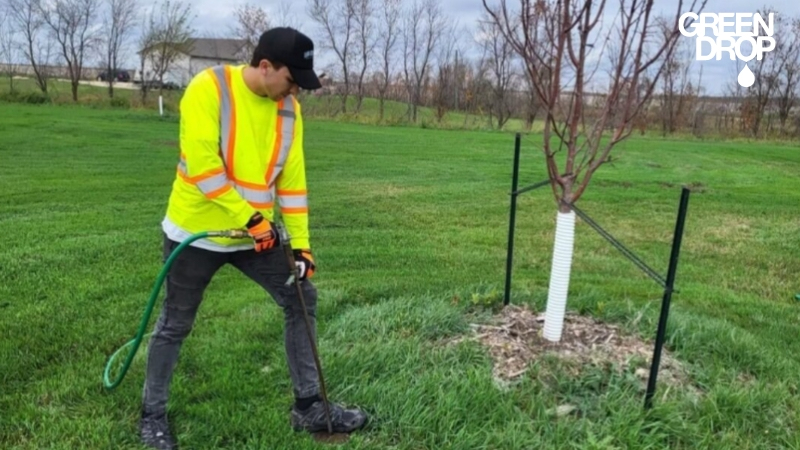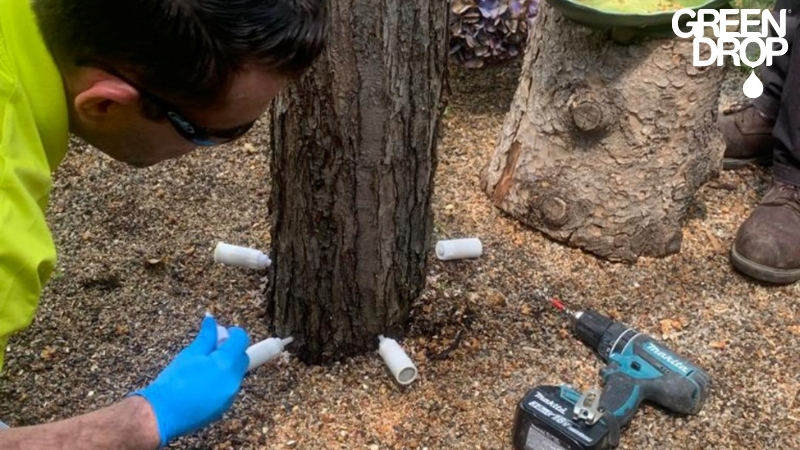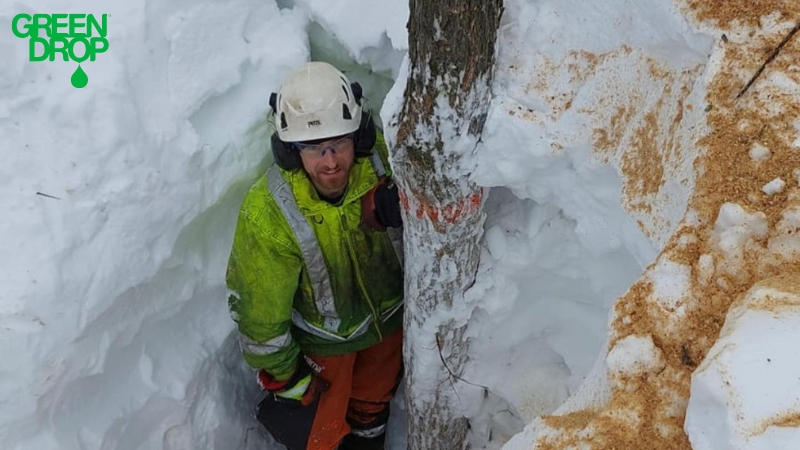Delayed Winter Injury – What It Is & How Can You Prevent it?
Reading time: 6 minutesYour trees come out the other side of winter ready to roll into spring in all their majesty—and then bam! Winter strikes a low blow after the bell, and you discover your tree has a delayed winter injury (DWI).
This can wreak some serious havoc on our green buddies, especially the younger, green-behind-the-ears types. In Saskatoon especially, where winter can be quite sneaky, young trees and fruit plants are very much at risk of DWI.
Stick with us, and we’ll guide you through what you’re dealing with and how you can shield your trees from winter's moods.

Understanding Delayed Winter Injury
What Causes DWI
Imagine this: it’s a mild winter day as we head into spring. Everything’s thawing a bit, and your trees are beginning to wake up. And suddenly, the temperatures plummet back below freezing.
This kind of temperature rollercoaster can cause what's called "delayed winter injury." It happens because the plant tissues, fooled by the warm spell, lose their cold hardiness. When the mercury drops again, the sap inside these plants refreezes, expanding and causing the cells to burst like tiny ice balloons.
The real trouble kicks in when these cells are in the plant’s vascular tissue, which is the plant's essential water and nutrient highways. The impact? Your trees might be ready to burst into life when spring rolls around but then don’t have enough juice to do it.
The result can range from branches drying out to entire plants saying goodbye, depending on how severe the freeze-thaw whiplash was. And with our changing climate, these unpredictable warm spells in the heart of winter are becoming more frequent, making delayed winter injury a recurring theme.
Symptoms of DWI
As spring ushers in, some trees and shrubs might show false signs of beginning to bloom by leafing out. However, if these initial signs of revival are followed by a sudden decline in growth and vitality, DWI may be the culprit.
The condition often reveals itself quite subtly:
- You might see your tree begin the season with a flourish of leaves or flowers, and in a matter of days, start struggling to maintain them.
- The branches might show signs of gradual withering, unable to sustain the lush growth due to compromised vascular tissues beneath the bark. Stunted growth is a dead giveaway of DWI.
It’s the internal damage caused by the condition that’s the main culprit, affecting the tree's ability to transport water and nutrients effectively. In severe cases, you might notice entire branches, or even the whole tree, succumbing as the growing season progresses.

How to Confirm DWI
When suspecting delayed winter injury, don your detective hat and start digging—not in the dirt, but through weather archives! Pop over to your local weather website and take a look at winter's temperature logs. You're on the lookout for any fluctuating temperatures or standout spikes that took the mercury above zero before diving back into freezing territory.
If the temperature clues point toward DWI, it’s time to get your hands dirty with these 2 simple steps:
- Grab a small branch that seems under the weather and make a clean cut.
- What you're after is the ring just beneath the bark. Healthy wood should flaunt a creamy or white hue. If you spot a circle of brown, tan, or grey, it's a tell-tale sign of vascular distress.
This simple inspection can give you a good clue about the tree's inner turmoil, helping you understand just how much care it’ll need to bounce back.
Impact on Tree Health and Longevity
You shouldn’t take DWI lightly. It doesn’t throw a temporary wrench in your trees’ growth; it has long-term repercussions on their overall health and lifespan.
The damage to the vascular system affects your trees’ ability to muster enough energy to maintain growth or sprout any foliage. Without sufficient nutrients and water making their way up from the roots, they can't sustain new growth.
Over time, this can lead to a gradual decline in health, making your trees less robust and shortening their expected lifespans. They become like that old car that looks fine on the outside but is always in the garage for repairs.
Regular monitoring is essential to keep your silent green friends from suffering in silence. You want to give them the best chance to regain their vigour and continue to thrive in your yard for many seasons to come.

Preventing Delayed Winter Injury
Preventing DWI in your Saskatoon yard may seem like having to predict the weather, but there’s more to it than that. Here are a few ways some planned tree care can help protect from it:
- Choose species and cultivars well-suited to withstand sudden temperature shifts typical of the Saskatoon climate. Opt for native or hardy varieties known for their resilience to cold snaps.
- Plant trees and shrubs at the correct depth. Make sure the trunk flare is just above the soil surface. Avoid planting too deeply, as this can stress the plant and make it more susceptible to winter injury.
- Correct any circling or girdling roots before planting, as these can also stress the plant and increase susceptibility to damage.
- Avoid heavy fertilization in the late fall. Late-season nitrogen can promote new growth that won't harden off in time for winter, making plants more vulnerable to injury.
- Consider a balanced approach or a potassium-rich fertilizer (like our RootBoost™) to strengthen cell walls and enhance root development without encouraging tender new growth.
- Thoroughly water your evergreens and other susceptible plants before the ground freezes. This helps ensure they have sufficient moisture reserves to last through winter, especially during unseasonably warm spells.
- Water deeply and infrequently to encourage strong root systems capable of reaching deeper, less likely to freeze moisture sources.
- Apply a generous layer of mulch around the base of trees and shrubs to help insulate the soil and roots. This can prevent rapid temperature fluctuations in the soil that contribute to root damage.
- Use burlap screens or windbreaks to protect vulnerable plants from drying winter winds and warm winter sun that can trigger de-acclimatization. Position these screens strategically to shield plants without completely blocking off winter sunlight, which is essential even during dormancy.
The Aftermath: Rehab and Recovery
When dealing with the aftermath of a delayed winter injury, a gentle hand and patient approach are key to rehabilitation and recovery. Provide consistent moisture to stressed trees, especially as the weather warms. Ensure the soil around the roots stays moist but not waterlogged, as overwatering can stress the tree further and lead to root rot.
Once the damage is clearly identified, we might need to prune out dead or dying branches. This helps prevent disease spread and focuses the tree’s energy on recovery. We always use clean, sharp tools to make clean cuts so that the tree can seal more effectively.

Secure Your Trees’ Futures with Green Drop
Navigating the challenges of delayed winter injury requires proactive care and a keen eye to catch it early. Sometimes, it takes a certified arborist to confirm your suspicions and help get your tree back in tip-top shape.
Our team of ISA-certified arborists and Master Arborists are ready to provide tree healthcare services as well as emergency tree services across Western Canada. We offer specialized care designed to enhance the health and longevity of your trees.
Book a free estimate today, and let’s make sure your trees get the best possible care. We’re not just in Saskatoon but in Edmonton, Red Deer, Regina, Calgary, and Winnipeg too!

